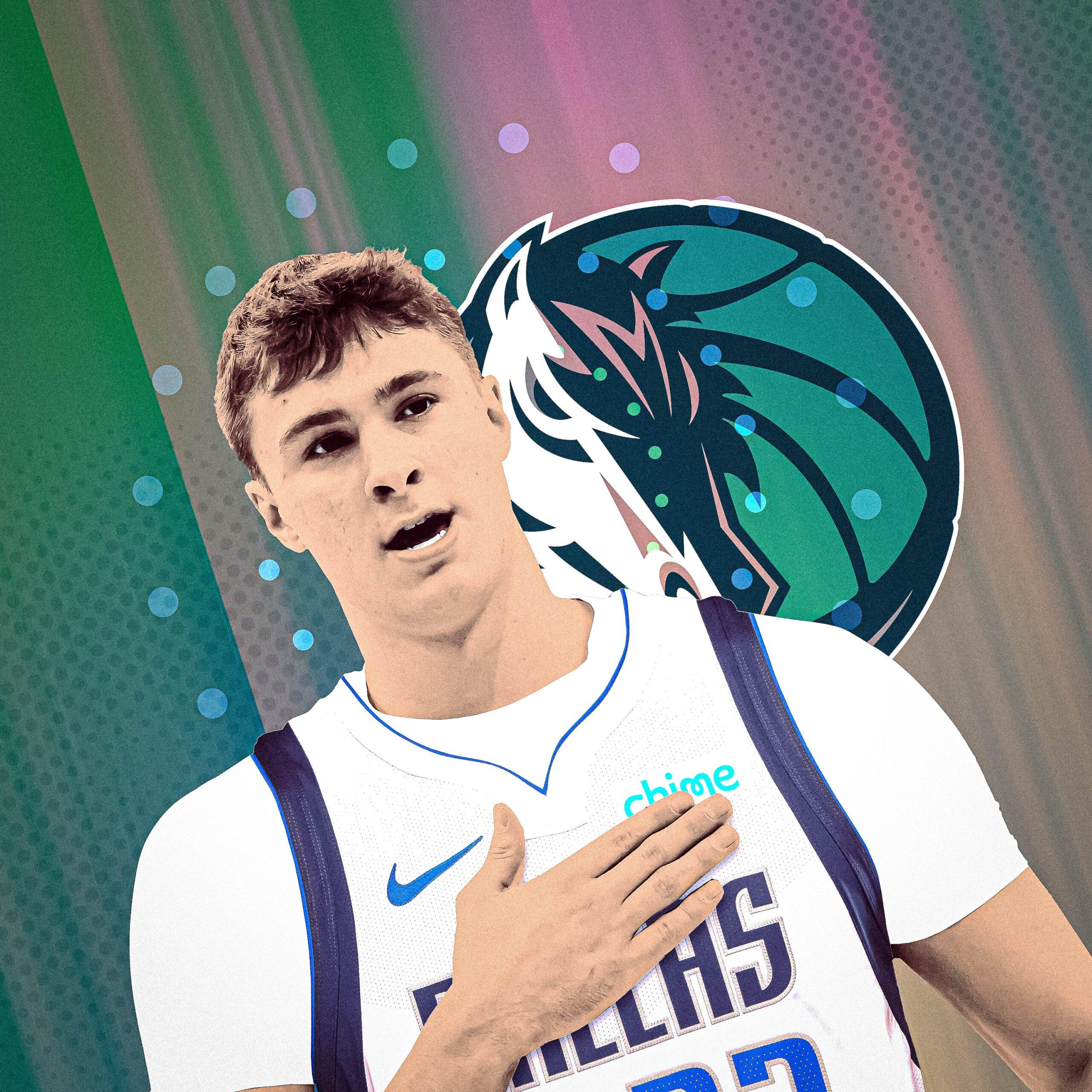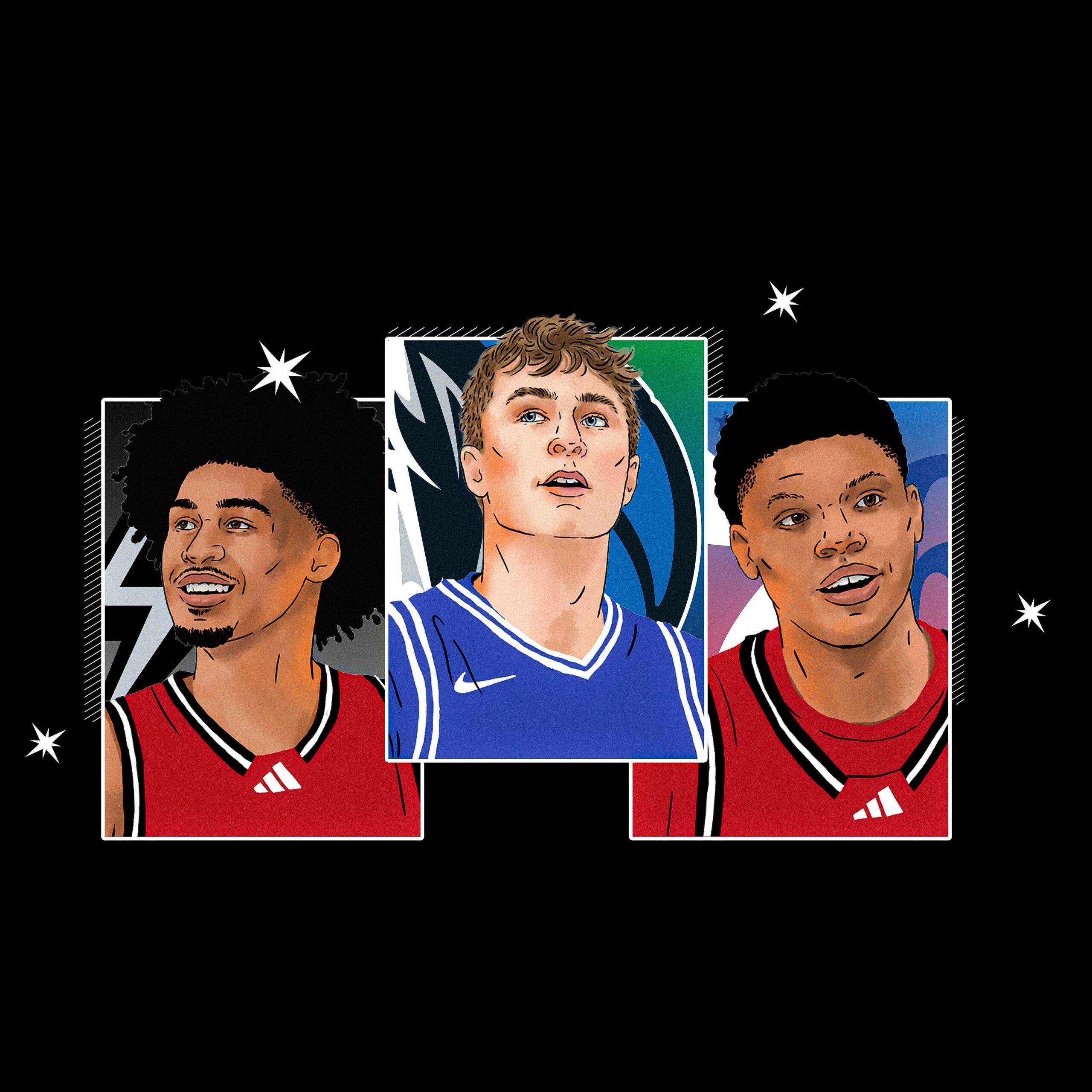
Less than a year ago, at the UNLV Mendenhall Center during a highly anticipated U.S. men’s national basketball team scrimmage in the lead-up to the 2024 Olympics, a 17-year-old Cooper Flagg confidently brought the ball into the frontcourt, where he was hounded by Jrue Holiday, who was relentlessly trying to find a hole in Flagg’s still-emergent on-ball game. Flagg’s sudden stab dribble dislodged Holiday by several feet, effectively forcing the U.S. senior team into a switch on an impromptu pick-and-roll. Suddenly, in front of Flagg was Anthony Davis. In an instant, Flagg had gone from one generational defender to another. Still, no fear. Flagg took a dribble, then rose up for a 3, right in AD’s face. Swish. The very next possession: Flagg got the ball on an errant lob pass to AD and threw a perfect hit-ahead pass in transition to Keegan Murray for a 3. It was a miss, but Flagg was quicker to react than anyone else on the floor. He flew in for the putback. And-1. Those 25 seconds exemplified Flagg’s omnipresent impact on the game. And in that sequence, we caught a glimpse into a possible—likely?—future. A future no one could have foreseen at any point before the moment when the San Antonio Spurs were announced as the holders of the no. 2 pick in the 2025 NBA draft.
The Dallas Mavericks, the team that disrupted the natural order of basketball and disrespected an entire fan base by trading away Luka Doncic in February, got a mulligan from the basketball gods (or from the league office and relevant stakeholders, depending on how much tinfoil you have on hand). Those Mavericks just won the lottery, jumping 10 spots in a shocking bookend to one of the most shocking seasons in NBA history. There are myriad ways to rationalize the inexplicable. Is this the work of instant karma? Is this a public relations crisis management master class? Or could it truly just be dumb, cosmic luck? Dallas had a 1.8 percent chance of landing the no. 1 pick—nearly half as likely as the asteroid known as 2024 YR4 crashing into our moon in 2032 and leaving a crater visible from Earth.
This was just the fourth instance since the draft lottery system was instituted in 1985 that a team won the rights to the no. 1 pick despite having less than a 2 percent chance of landing it (the other instances: 1993, 2008, 2014). The last time a team won the lottery with such long odds was when the Cleveland Cavaliers won the rights to Andrew Wiggins despite having only a 1.7 percent chance. Of course, that’s relevant because Wiggins was famously held in a months-long offseason purgatory as the Cavaliers and Timberwolves played chicken on a deal that would eventually send Wiggins to Minnesota in exchange for Kevin Love. If the past few months of high NBA drama are any indication, it isn’t outside the realm of possibility for that scenario to play out once again. Looming over the lottery results was the report of Giannis Antetokounmpo’s openness to exploring his career options outside of Milwaukee. Dallas has made its love for Giannis known—a longing for the one that got away that has reverberated for years. Could the Mavericks do it again—and by again, I mean find a way to trade away a young, transcendent talent for another (albeit better) version of Anthony Davis?
Flagg was stoic as the ESPN cameras panned to his reaction. Understandable. In Nico Harrison’s hands, anything is possible (derogatory). Anything is on the table. A night when Flagg was supposed to get a peek at his new beginning—and get a sense of what could be the next four years, eight years, his entire career—became stilted. It became a night of shock and subtext that had nothing to do with him and yet everything to do with his future. Flagg now enters uncertain waters—is he a franchise savior or the ultimate wheel greaser in someone else’s grand design?
Lost in the shock and the sheer unlikeliness of it all is the franchise-altering potential housed in Flagg’s 6-foot-9 frame. He will be the first American no. 1 pick since Paolo Banchero in 2022, the most anticipated American talent since Zion Williamson, and the best overall American prospect since Anthony Davis. No pressure. No pressure at all, buddy. But those scrimmages showed just how game he is to carry the weight of expectations on his shoulders. Flagg is one of the cleanest evaluations for a no. 1 pick in the past 10 years. The national player of the year awards and his consensus All-American accolade as a freshman are impressive, but arguably more compelling is how Flagg already has the respect of some of the best players in the world as a result of his performance with the U.S. men’s select team. He was the first collegiate player to participate in the program in more than a decade. (Collegiate is more of a technicality, given that he was closer to his high school graduation date than his first NCAA game.) Yet, in a straw poll conducted by The Athletic, Flagg was overwhelmingly considered the best player on the select team, whose roster included then-current and future Ringer Top 100 players Trey Murphy III, Amen Thompson, Jalen Suggs, Jalen Duren, and Brandon Miller. Again, he was 17.
With all the hype and anticipation, there are bound to be some skeptics. But the cognitive biases that might be held against him are largely a matter of form, not function. He doesn’t move the way we’re accustomed to seeing a creator move. Flagg’s classical frame and explosive, two-footed leaping reinforce the power in his power wing designation. His handle is rigid; the architecture of his game hews more brutalist than expressionist. Not bad, just different. Should Dallas hold on to the pick, it’ll be a difference worth embracing.
Flagg is a universal two-way player, capable of impacting the game from every angle. At his core, he is a high-motor defensive playmaker with exceptional gifts—his instincts, pattern recognition, length, and ground coverage instantly make him an ideal weakside rim protector and low-man helper. In that sense, he’s already a man after Harrison’s own heart. And, whether the critiques of Luka are fair or not, the effort and intensity that Flagg exudes on defense are very much the inverse of Doncic’s impact on that end. Since 2003, there have been 12 non-centers drafted in the first round that produced steal and block rates comparable to Flagg’s at the NCAA level; most were drafted as defensive specialists in the mid-to-late stages of the top 30. The only other lottery player in that cohort is fellow Dukie Zion Williamson, taken no. 1 in 2019—and, lest we forget, before injuries and conditioning issues shifted Zion’s on-court priorities, he had game-breaking defensive potential.
That defensive drive has been there from the very start. The first time Flagg truly pierced the broader basketball consciousness was at the 2022 FIBA U17 Basketball World Cup finals in Malaga, Spain. In just under seven seconds, he showed the world his preternatural defensive gifts, blocking tournament MVP Izan Almansa (a fellow 2025 draft hopeful) four times on the same possession. Coordination, timing, tenacity, and a fiendishly regenerative second, third, and fourth jump.
It was an early glimpse of prodigy. Flagg was just 15 years old then, with only one season of high school basketball under his belt—albeit the greatest freshman season in Maine basketball history—not yet playing for the legendary Kevin Boyle at Montverde Academy, where he would cement his status as a phenom.
Word got out to Brian Scalabrine even earlier. Sometime around 2020, Flagg’s longtime trainer, Matt MacKenzie, regaled Scal with stories of a 13-year-old Cooper competing against D-I University of Maine players and busting their asses. Scal was incredulous; there is no way a kid could do that to grown men. He had to see it for himself. So he invited the teenage Flagg to the high-level pickup games he ran in Boston. “First possession, he goes to the right and he pump-fakes,” Scalabrine recounted to Julian Edelman on the Games With Names podcast: “He throws it up off the backboard, goes up with the left, and dunks it. The gym was silent.” Scalabrine got in touch with Team USA the very next day.
What makes Flagg a surefire top pick, however, is just how quickly his offensive game has coalesced in the span of one college campaign. His jumper was a question mark heading into his freshman year but became an unexpected strength in the latter stages of the season: Flagg hit 39 percent of his catch-and-shoot attempts from behind the arc as a Blue Devil, per Synergy Sports. The threat of his improved shooting opened up the rest of his game and allowed him to make the most of his ever-valuable reps as a ball handler in the pick-and-roll, which made up nearly a fifth of Flagg’s offensive possessions.
As LeBron James and Steve Nash discussed last month in an episode of Mind the Game, and as I explored in a predraft profile of Cade Cunningham in 2021, there are distinct advantages afforded to a player of this size who is comfortable initiating a pick-and-roll. “Through his early days as a big, he had a strong grasp on setting screens and how certain angles would dislodge the defender in certain ways,” I wrote of Cade in 2021, but this also applies to Flagg. “Now, as the handler, he could apply that internal data to manipulate both his own screener and the opponent as though he were running simulations of possible avenues in real time. Few players his age have as advanced an understanding of pick-and-roll craft because few players his age have had as much experience inhabiting both roles.”
It is through Flagg’s burgeoning on-ball game that his superstar potential shines. There was obviously a Luka-shaped hole in the Mavericks offense in the second half of this past season—Flagg may not be an all-time talent as a passer, but it isn’t hard to imagine him superimposed on the Mavs offense as it was, figuring out his own style on the fly. Flagg intuits the advantages laid before him with ease: He’s eager to punish any mismatch if opponents switch the pick-and-roll; he has the vantage points, the leverage, and the touch to make crosscourt passes over the tops of defenses; he drives hard without shying from contact. Flagg’s ballhandling will need to improve, as the self-determination it unlocks is central to the superstar wing thesis—just ask Kawhi Leonard and Paul George, who became the best possible versions of themselves through outlier development of their respective handles. Until that comes around, however, Flagg has the advantage of also being able to work the other end of the two-man game, creating out of four-on-three advantages. The Mavs employ two of the most efficient vertical-spacing big men in the league in Dereck Lively II and Daniel Gafford; they feasted playing alongside Luka. They could feast again with Cooper. Just ask Alabama and Arizona how dangerous Flagg is as a lob artist.
As with Victor Wembanyama in 2023, Flagg’s status as the consensus choice at no. 1 feels like a meeting with destiny scheduled years in advance. But where Wemby arrived as an unprecedented force, Flagg will step into an unavoidable shadow, forever tied to Doncic’s curtailed legacy in Dallas. They say comparison is the thief of joy, but a talent like Flagg has the power to break from those constraints. It’s a joyous day in Dallas, in spite of everything. Maybe that’s enough for now. But the basketball universe is now conditioned to expect shock waves at every corner. The Dallas Mavericks walked into the miracle of Cooper Flagg. No one has any idea what comes next.


